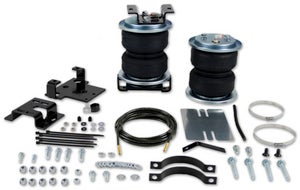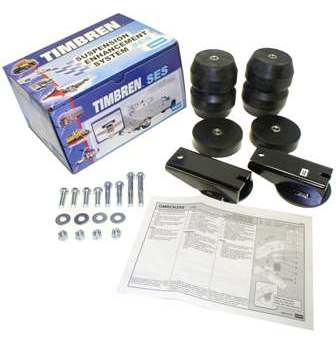Do you have a truck and it sags more than you like when towing a trailer or a hauling a bed full of supplies? Ever wonder what is the best solution to get rid of the suspension sag, so your truck drives normally?
These are common questions and we will touch on a few of the pros and cons of each to make your buying decision a little easier.
Which is better? In our experience over the years, we've found that both air suspension kits and kits that don't use air will reduce suspension sag. If you search the web, you'll find truck, motorhome and SUV owners around the world using one or the other, that would recommend either of them to friends. Rather than ask which is better, perhaps a better question is “Which suspension kit is better for me?”
Pros and Cons? Lets take a quick look and a few of the pros and cons of each kit to help you weigh your decision.

AIR SPRING KITS:
Firestone Ride-Rite
Firestone Coil-Rite
Firestone Sport-Rite
Air Lift Load-Lifter 5000
Air Lift 1000
Air Lift Ride-Control
Hellwig Air Springs
Pros:
Air adjustable: A little obvious, but this is the major plus that a non-air kit can never overcome, the ability to adjust your truck to the desired ride height. Hook up your trailer, truck sags a few inches, no problem. Inflate the air springs until your truck is level. Done towing and just using the truck for the daily commute? Simply remove the air pressure until air springs are at the minimum required air pressure, and your good to go.
Level Side-to-Side: Have a motorhome with a tank full of water on one side, or a pickup with a slide in camper and your leaning to one side? With air springs, you have the option of running a “T” fitting and inflating both the air springs equally, or running the air lines separately to each bag which allows you to increase the pressure on one side over the other. This allows you to level out the side with the water tank, etc.
Cons:
Air Leaks, holes, etc. Yes, using air to level your truck is a major plus, and the advantages do outweigh the disadvantages, but air does require more attention and opens the door for cons that a non-air load leveling kit will never experience. When dealing with air, you have the potential to run into leaks, damaged air line, holes in air springs etc. These problems can all be easily repaired, and are not very common in the big picture, but they do happen. If you're planning on extensive travel, it's never a bad idea to have a spare air spring and some air line. Replacement air springs and air line are readily available and not very expensive.
Time to install: You will have to allow yourself a few more hours to install an air suspension kit. The instructions get better every year and now include detailed images, and many kits are no-drill, bolt on installations, but it still can be time consuming. They are not technically difficult to install, but it can take some time to cut, run the air lines, etc. Click to view the Air Lift 57275 installation instructions for the Chevy 2500HD and GMC Sierra 2500HD.
Maintaining Minimum Air Pressure: This is about as easy as it gets, but is one of the major causes of air spring failure. All kits require a minimum air pressure, usually 5-10 PSI. While its easy to check them while filling up for gas or washing your truck, people tend to forget. Running air springs without the minimum air pressure can cause them to tear or rub against something causing a hole. The best solution if your concerned about this, is an air compressor kit. This gives you the ability to monitor the air pressure from inside the cab and takes all the guessing away.

NON-AIR SUSPENSION
LOAD LEVELING KITS
Timbren Kits
Air Lift Air Cell Kits
Firestone Work-Rite Kits
Pros:
Install and forget: Once you install a rubber or urethane suspension kit, your done. No worrying about air pressure, leaks, etc. They are maintenance free, and are great for company trucks, when other employees may be driving them.
Easy to install: Installation for these kits usually takes about an hour, and can be done with simple hand tools. For most installations you simply unbolt your existing rubber bump stop, and bolt the rubber spring in its place. For a sample installation, view the Timbren GMRCK25S Installation Instructions for the Chevy Silverado 2500HD and Sierra 2500HD.
Cost: These kits typically are $180-$300, depending on your appliation. Cost to install is also less than installation of an air spring kit, if you're not planning on doing it yourself.
Cons:
Not Adjustable: While these suspension kits are progressive, and will stiffen up when a load is placed on them, you do not have the ability to adjust it to the exact desired height as you do an air bag kit. The rubber or urethane springs will expand and contract with the varying load conditions, but you cannot control the ride height or the stiffness of the springs.
Summary
Both air adjustable and non-air suspension kits will help reduce suspension sag, prevent body roll, reduce sway, and help level out your vehicle. Adjustability, maintenance, installation time, and cost differentiate the various kits. We hope this helps clear up some of the differences between them.
Positive feedback can be found on both types of kits. Feel free to post your comments on the experiences you have had with either of the two, that may help someone else decide “Which suspension kit is best for me?”